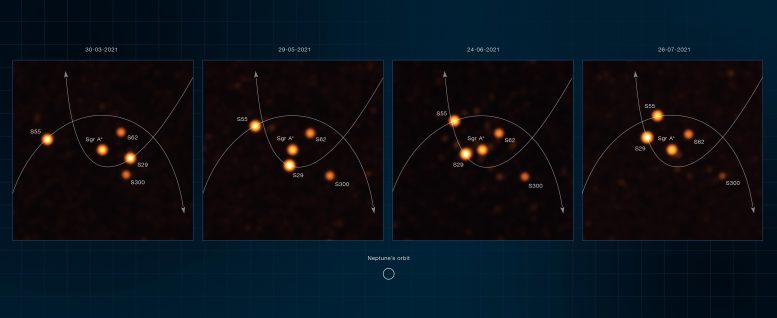
These annotated images, obtained with the GRAVITY instrument on ESO’s Very Large Telescope Interferometer (VLTI) between March and July 2021, show stars orbiting very close to Sgr A*, the supermassive black hole at the heart of the Milky Way. One of these stars, named S29, was observed as it was making its closest approach to the black hole at 13 billion kilometers, just 90 times the distance between the Sun and Earth. Another star, named S300, was detected for the first time in the new VLTI observations. To obtain the new images, the astronomers used a machine-learning technique, called Information Field Theory. They made a model of how the real sources may look, simulated how GRAVITY would see them, and compared this simulation with GRAVITY observations. This allowed them to find and track stars around Sagittarius A* with unparalleled depth and accuracy. Credit: ESO/GRAVITY collaboration
The European Southern Observatory’s Very Large Telescope Interferometer (ESO’s VLTI) has obtained the deepest and sharpest images to date of the region around the supermassive black hole at the center of our galaxy. The new images zoom in 20 times more than what was possible before the VLTI and have helped astronomers find a never-before-seen star close to the black hole. By tracking the orbits of stars at the center of our Milky Way, the team has made the most precise measurement yet of the black hole’s mass.
“We want to learn more about the black hole at the center of the Milky Way, Sagittarius A*: How massive is it exactly? Does it rotate? Do stars around it behave exactly as we expect from Einstein’s general theory of relativity? The best way to answer these questions is to follow stars on orbits close to the supermassive black hole. And here we demonstrate that we can do that to a higher precision than ever before,” explains Reinhard Genzel, a director at the Max Planck Institute for Extraterrestrial Physics (MPE) in Garching, Germany who was awarded a Nobel Prize in 2020 for Sagittarius A* research. Genzel and his team’s latest results, which expand on their three-decade-long study of stars orbiting the Milky Way’s supermassive black hole, are published today in two papers in Astronomy & Astrophysics.
On a quest to find even more stars close to the black hole, the team, known as the GRAVITY collaboration, developed a new analysis technique that has allowed them to obtain the deepest and sharpest images yet of our Galactic Centre. “The VLTI gives us this incredible spatial resolution and with the new images we reach deeper than ever before. We are stunned by their amount of detail, and by the action and number of stars they reveal around the black hole,” explains Julia Stadler, a researcher at the Max Planck Institute for Astrophysics in Garching who led the team’s imaging efforts during her time at MPE. Remarkably, they found a star, called S300, which had not been seen previously, showing how powerful this method is when it comes to spotting very faint objects close to Sagittarius A*.
With their latest observations, conducted between March and July 2021, the team focused on making precise measurements of stars as they approached the black hole. This includes the record-holder star S29, which made its nearest approach to the black hole in late May 2021. It passed it at a distance of just 13 billion kilometers, about 90 times the Sun-Earth distance, at the stunning speed of 8740 kilometers per second (~20,000,000 mph). No other star has ever been observed to pass that close to, or travel that fast around, the black hole.
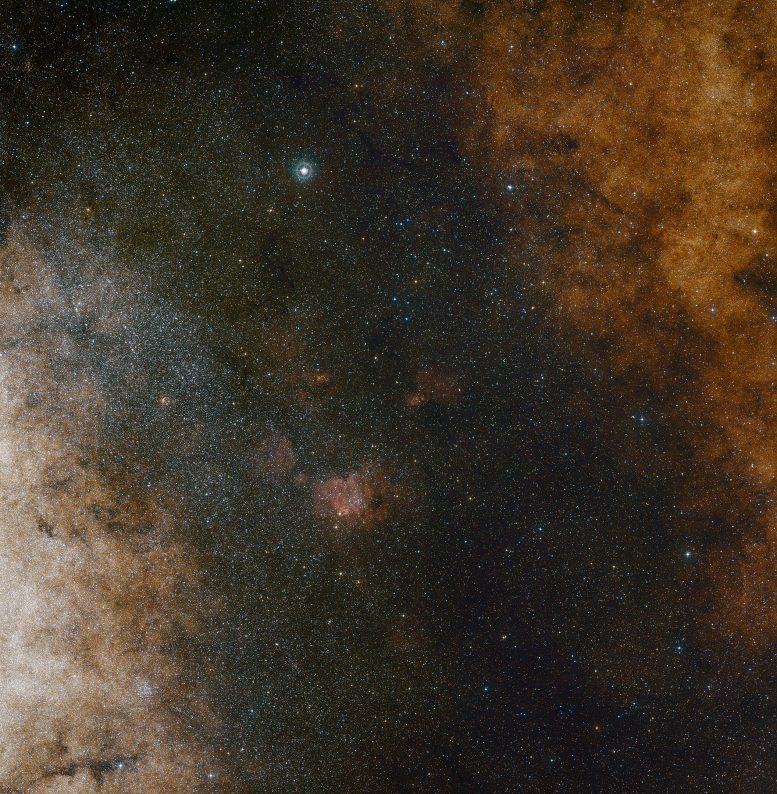
Wide-field view of the center of the Milky Way. This visible light wide-field view shows the rich star clouds in the constellation of Sagittarius (the Archer) in the direction of the center of our Milky Way galaxy. The entire image is filled with vast numbers of stars — but far more remain hidden behind clouds of dust and are only revealed in infrared images. This view was created from photographs in red and blue light and forming part of the Digitized Sky Survey 2. The field of view is approximately 3.5 degrees x 3.6 degrees. Credit: ESO and Digitized Sky Survey 2. Acknowledgment: Davide De Martin and S. Guisard (www.eso.org/~sguisard)
The team’s measurements and images were made possible thanks to GRAVITY, a unique instrument that the collaboration developed for ESO’s VLTI, located in Chile. GRAVITY combines the light of all four 8.2-meter telescopes of ESO’s Very Large Telescope (VLT) using a technique called interferometry. This technique is complex, “but in the end you arrive at images 20 times sharper than those from the individual VLT telescopes alone, revealing the secrets of the Galactic Center,” says Frank Eisenhauer from MPE, principal investigator of GRAVITY.
“Following stars on close orbits around Sagittarius A* allows us to precisely probe the gravitational field around the closest massive black hole to Earth, to test General Relativity, and to determine the properties of the black hole,” explains Genzel. The new observations, combined with the team’s previous data, confirm that the stars follow paths exactly as predicted by General Relativity for objects moving around a black hole of mass 4.30 million times that of the Sun. This is the most precise estimate of the mass of the Milky Way’s central black hole to date. The researchers also managed to fine-tune the distance to Sagittarius A*, finding it to be 27,000 light-years away.
To obtain the new images, the astronomers used a machine-learning technique, called Information Field Theory. They made a model of how the real sources may look, simulated how GRAVITY would see them, and compared this simulation with GRAVITY observations. This allowed them to find and track stars around Sagittarius A* with unparalleled depth and accuracy. In addition to the GRAVITY observations, the team also used data from NACO and SINFONI, two former VLT instruments, as well as measurements from the Keck Observatory and NOIRLab’s Gemini Observatory in the US.
GRAVITY will be updated later this decade to GRAVITY+, which will also be installed on ESO’s VLTI and will push the sensitivity further to reveal fainter stars even closer to the black hole. The team aims to eventually find stars so close that their orbits would feel the gravitational effects caused by the black hole’s rotation. ESO’s upcoming Extremely Large Telescope (ELT), under construction in the Chilean Atacama Desert, will further allow the team to measure the velocity of these stars with very high precision. “With GRAVITY+’s and the ELT’s powers combined, we will be able to find out how fast the black hole spins,” says Eisenhauer. “Nobody has been able to do that so far.”
This research was presented in two GRAVITY Collaboration papers to appear in Astronomy & Astrophysics.
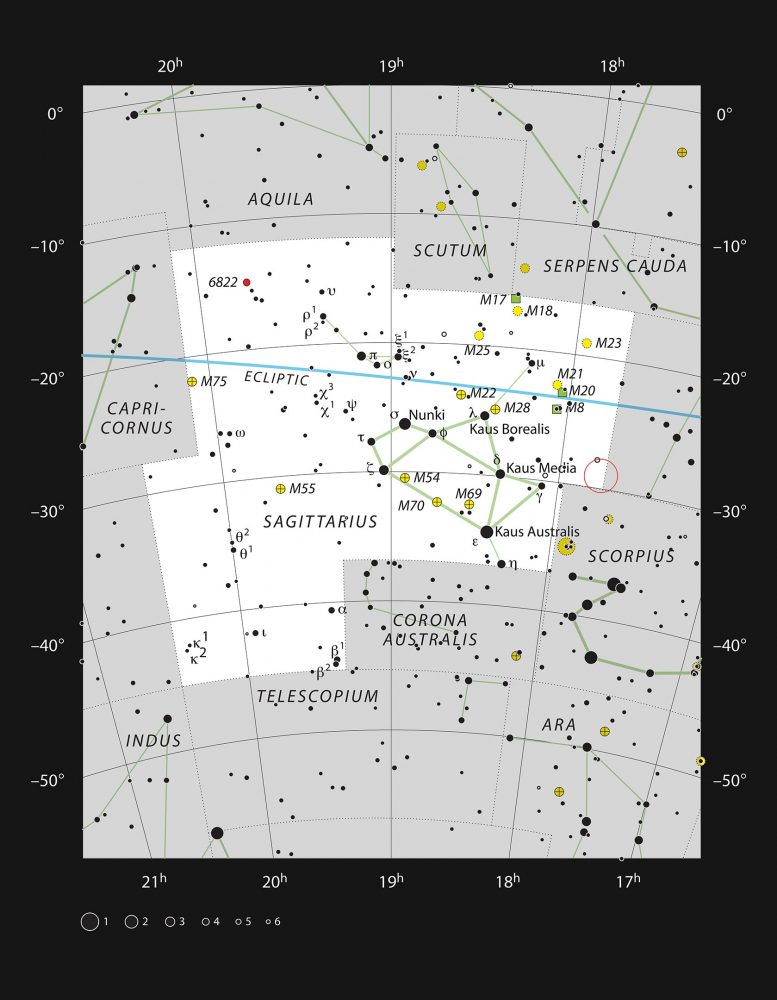
This chart shows the location of the field of view within which Sagittarius A* resides — the black hole is marked with a red circle within the constellation of Sagittarius (The Archer). This map shows most of the stars visible to the unaided eye under good conditions. Credit: ESO, IAU and Sky & Telescope
References:
“Mass distribution in the Galactic Center based on interferometric astrometry of multiple stellar orbits” by GRAVITY Collaboration: R. Abuter, N. Aimar, A. Amorim, J. Ball, M. Bauböck, J. P. Berger, H. Bonnet, G. Bourdarot, W. Brandner, V. Cardoso, Y. Clénet, Y. Dallilar, R. Davies, P. T. de Zeeuw, J. Dexter, A. Drescher, F. Eisenhauer, N. M. Förster Schreiber, A. Foschi, P. Garcia, F. Gao, E. Gendron, R. Genzel, S. Gillessen, M. Habibi, X. Haubois, G. Heißel,??, T. Henning, S. Hippler, M. Horrobin, L. Jochum, L. Jocou, A. Kaufer, P. Kervella, S. Lacour, V. Lapeyrère, J.-B. Le Bouquin, P. Léna, D. Lutz, T. Ott, T. Paumard, K. Perraut, G. Perrin, O. Pfuhl, S. Rabien, J. Shangguan, T. Shimizu, S. Scheithauer, J. Stadler, A.W. Stephens, O. Straub, C. Straubmeier, E. Sturm, L. J. Tacconi, K. R. W. Tristram, F. Vincent, S. von Fellenberg, F. Widmann, E. Wieprecht, E. Wiezorrek, J. Woillez, S. Yazici and A. Young, 19 January 2022, Astronomy & Astrophysics.
DOI: 10.1051/0004-6361/202142465
“Deep images of the Galactic center with GRAVITY” by GRAVITY Collaboration: R. Abuter, N. Aimar, A. Amorim, P. Arras, M. Bauböck, J. P. Berger, H. Bonnet, W. Brandner, G. Bourdarot, V. Cardoso, Y. Clénet, R. Davies, P. T. de Zeeuw, J. Dexter, Y. Dallilar, A. Drescher, F. Eisenhauer, T. Enßlin, N. M. Förster Schreiber, P. Garcia, F. Gao, E. Gendron, R. Genzel, S. Gillessen, M. Habibi, X. Haubois, G. Heißel, T. Henning, S. Hippler, M. Horrobin, A. Jiménez-Rosales, L. Jochum, L. Jocou, A. Kaufer, P. Kervella, S. Lacour, V. Lapeyrère, J.-B. Le Bouquin, P. Léna, D. Lutz, F. Mang, M. Nowak, T. Ott, T. Paumard, K. Perraut, G. Perrin, O. Pfuhl, S. Rabien, J. Shangguan, T. Shimizu, S. Scheithauer, J. Stadler, O. Straub, C. Straubmeier, E. Sturm, L. J. Tacconi, K. R. W. Tristram, F. Vincent, S. von Fellenberg, I. Waisberg, F. Widmann, E. Wieprecht, E. Wiezorrek, J. Woillez, S. Yazici, A. Young and G. Zins, 19 January 2022, Astronomy & Astrophysics.
DOI: 10.1051/0004-6361/202142459
More information
The team who authored the paper “The mass distribution in the Galactic Centre from interferometric astrometry of multiple stellar orbits” is composed of: R. Abuter (European Southern Observatory, Garching, Germany [ESO]), A. Amorim (Universidade de Lisboa – Faculdade de Ciências, Portugal and Centro de Astrofísica e Gravitação, IST, Universidade de Lisboa, Portugal [CENTRA]), M. Bauböck (Max Planck Institute for Extraterrestrial Physics, Garching, Germany [MPE] and Department of Physics, University of Illinois, USA), J. P. Berger (Univ. Grenoble Alpes, CNRS, Grenoble, France [IPAG] and ESO), H. Bonnet (ESO), G. Bourdarot (IPAG and MPE), W. Brandner (Max Planck Institute for Astronomy, Heidelberg, Germany [MPIA]), V. Cardoso (CENTRA and CERN, Genève, Switzerland), Y. Clénet (Observatoire de Paris, Université PSL, CNRS, Sorbonne Université, Université de Paris, Meudon, France [LESIA]), Y. Dallilar (MPE), R. Davies (MPE), P. T. de Zeeuw (Sterrewacht Leiden, Leiden University [Leiden], The Netherlands and MPE), J. Dexter (Department of Astrophysical & Planetary Sciences, JILA, Duane Physics Bldg.,University of Colorado [Colorado], Boulder, USA), A. Drescher (MPE), A. Eckart (1st Institute of Physics, University of Cologne, Germany [Cologne] and Max Planck Institute for Radio Astronomy, Bonn, Germany), F. Eisenhauer (MPE), N. M. Förster Schreiber (MPE), P. Garcia (Faculdade de Engenharia, Universidade do Porto, Portugal and CENTRA), F. Gao (Hamburger Sternwarte, Universität Hamburg, Germany and MPE), E. Gendron (LESIA), R. Genzel (MPE and Departments of Physics and Astronomy, Le Conte Hall, University of California, Berkeley, USA), S. Gillessen (MPE), M. Habibi (MPE), X. Haubois (European Southern Observatory, Santiago, Chile [ESO Chile]), G. Heißel (LESIA), T. Henning (MPIA), S. Hippler (MPIA), M. Horrobin (Cologne), L. Jochum (ESO Chile), L. Jocou (IPAG), A. Kaufer (ESO Chile), P. Kervella (LESIA), S. Lacour (LESIA), V. Lapeyrère (LLESIA), J.-B. Le Bouquin (IPAG), P. Léna (LESIA), D. Lutz (MPE), T. Ott (MPE), T. Paumard (LESIA), K. Perraut (IPAG), G. Perrin (LESIA), O. Pfuhl (ESO and MPE), S. Rabien (MPE), G. Rodríguez-Coira (LESIA), J. Shangguan (MPE), T. Shimizu (MPE), S. Scheithauer (MPIA), J. Stadler (MPE), O. Straub (MPE), C. Straubmeier (Cologne), E. Sturm (MPE), L. J. Tacconi (MPE), K. R. W. Tristram (ESO Chile), F. Vincent (LESIA), S. von Fellenberg (MPE), F. Widmann (MPE), E. Wieprecht (MPE), E. Wiezorrek (MPE), J. Woillez (ESO), S. Yazici MPE and Cologne), and A. Young (MPE).
The team who authored the paper “Deep images of the Galactic Center with GRAVITY” is composed of: R. Abuter (ESO), P. Arras (Max Planck Institute for Astrophysics [MPA], Garching, Germany and Department of Physics, Technical University Munich [TUM], Garching, Germany), M. Bauböck (MPE and Department of Physics, University of Illinois, USA), H. Bonnet (ESO), W. Brandner (MPIA), G. Bourdarot (IPAG and MPE), V. Cardoso (CENTRA and CERN), Y. Clénet (LESIA), P. T. de Zeeuw (Leiden and MPE), J. Dexter (Colorado and MPE), Y. Dallilar (MPE), A. Drescher (MPE), A. Eckart (Cologne and Max Planck Institute for Radio Astronomy, Bonn, Germany), F. Eisenhauer (MPE), T. Enßlin (MPA), N. M. Förster Schreiber (MPE), P. Garcia (Faculdade de Engenharia, Universidade do Porto, Portugal and CENTRA), F. Gao (Hamburger Sternwarte, Universität Hamburg, Germany and MPE), E. Gendron (LESIA), R. Genzel (MPE and Departments of Physics and Astronomy, Le Conte Hall, University of California, Berkeley, USA), S. Gillessen (MPE), M. Habibi (MPE), X. Haubois (ESO Chile), G. Heißel (LESIA), T. Henning (MPIA), S. Hippler (MPIA), M. Horrobin (Cologne), A. Jiménez-Rosales (MPE), L. Jochum (ESO Chile), L. Jocou (IPAG), A. Kaufer (ESO Chile), P. Kervella (LESIA), S. Lacour (LESIA), V. Lapeyrère (LESIA), J.-B. Le Bouquin (IPAG), P. Léna (LESIA), D. Lutz (MPE), T. Ott (MPE) , T. Paumard (LESIA) , K. Perraut (IPAG) , G. Perrin (LESIA) , O. Pfuhl (ESO and MPE), S. Rabien (MPE), J. Shangguan (MPE), T. Shimizu (MPE), S. Scheithauer (MPIA), J. Stadler (MPE , O. Straub (MPE), C. Straubmeier (Cologne), E. Sturm (MPE), L.J. Tacconi (MPE), K. R. W. Tristram (ESO Chile), F. Vincent (LESIA), S. von Fellenberg (MPE), I. Waisberg (Department of Particle Physics & Astrophysics, Weizmann Institute of Science, Israel and MPE), F. Widmann (MPE), E. Wieprecht (MPE), E. Wiezorrek (MPE), J. Woillez (ESO), S. Yazici (MPE and Cologne), A. Young (MPE) and G. Zins (ESO).

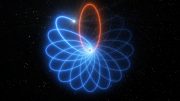

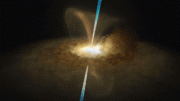

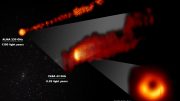


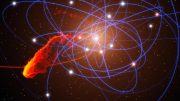
Quite oddly, there is no mention in this article of Andrea Ghez’s work, even at the evocation of the Nobel Prize, of which she’s a co-recipiendary – for her life-long career on Alpha-Sagitarius !
Notice they didn’t say anything about material streaming into the Black Hole. Read on.
While everyone is focused on supermassive Black Holes at the centers of galaxies, another possibility exists. According to String Theory, a brane (dimensional membrane) surrounds our universe. What if such branes, rather than Black Holes, are also the centers of galaxies? Superheated gas would also form around branes, and they would explain how the matter in the universe became concentrated as galaxies even as the universe was, and still is, flying apart from the Big Bang at a rate that absolutely won’t allow any matter (quarks, even) to gravitationally attract each other to form anything. It would also explain those low-mass stars at the center of the Milky Way and the Andromeda galaxy, and other curious phenomena seen at those centers. How would we know if the center is a Black Hole or a brane? If material (gas, etc.) is seen swirling into the center, it’s a Black Hole. If material doesn’t swirl in, that would be support for a brane. The physical creation of brane-centered galaxies using the quantum foam and similar to Hawking radiation can be described in my YouTube https://www.youtube.com/watch?v=IaxfuKXdhkg
More crap from NASA. Dont believe a word they say. There deceiving the world After all the very word NASA means deceive in Hebrew
Well, if its gravity the stars should slow down. Its like we are on a train and the background should be going faster but in fact isn’t moved yet at our speed. Seeing speed doesn’t mean its faster. I’m not sure what they are referring to when they speak of Einstein. That’s not what he published. He talk about siting on a train and everything seems to go faster when in fact its not moving or isn’t moveing as fast yet.. clearly not what Einstein stated in his published work..
It is curious the kinds of comments people leave on this scientific article about the black hole at the core of the Milky Way. Like Billie’s claim of financial gain. Or John’s whining about NASA when NASA had nothing to do with this research or the article. And then there were a couple attempts to discredit or at least disagree with the research around black holes.
I found the article quite interesting and look forward to future articles on the subject.
Loud production music annoying and not needed
Wow too all y@’ll… don’t forget about the little people below the equator…
This clip took 14years to make hardly “fast”